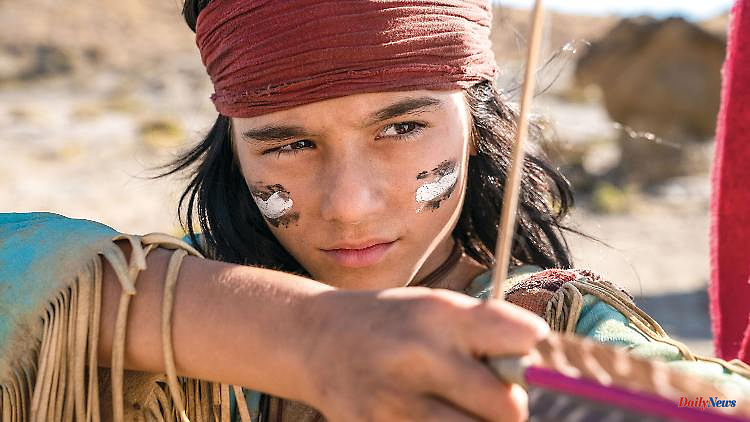Ravensburger Verlag is withdrawing two children's books that were supposed to appear at the same time as the film "The Young Winnetou". The film and books are based on Karl May's stories. The director of the Karl May Museum in Radebeul, Robin Leipold, is certain that the current debate does not do the author justice and that many publishers have no interest in showing indigenous cultures .
ntv.de: Are you surprised that a Karl May title can still provoke such controversial reactions?
Robin Leipold: I'm not entirely surprised. The trigger was the film of the same name, and I thought that it could be critically received today. The fact that a well-known publisher like Ravensburger decides to take the film books out of the program because Karl May romanticized everything and because the clichés from the colonial era have racist tendencies is exaggerated in my opinion. In principle, however, I think it is right to talk about topics such as cultural appropriation.
What would you have advised the film and book makers?
With Karl May you always have to be clear that he is a child of his time and an author who invented his stories. Winnetou never existed, nor did the Apaches he described. These were fantasy stories that he imagined 130 years ago.
Is it still possible today to implement a Karl May material in a contemporary way?
I find it difficult when it's done like it is now with this film or a few years ago by RTL: If you simply orientate yourself on the films from the 1960s. They were also freely adapted from Karl May and had not followed the books one-to-one. These were romantic and cliche tales: Pierre Brice as a noble Indian with a white blood brother and the sunset. I don't think you can do that anymore today.
But how do you get that on stage or filmed?
Open-air theaters like Bad Segeberg or Elspe say in no uncertain terms: We make western fairy tales, that's fantasy. This does not represent real Indians. It would also be problematic to make it culturally correct, for example by including ritual dances of the Indians. Then one really commits cultural appropriation and assumes ceremonial rites. That would be fatal. If you bring Karl May to the stage today, you always have to start with the fact that it all came from the imagination of this Saxon author. May couldn't travel, he had read books and dreamed these worlds up. You have to emphasize that more and maybe you could tell these stories as well.
To what extent should one also address the real fate of the indigenous peoples in North America?
I think you have to address what was done to the Indian peoples. But there we have a direct connection to Karl May, because he did it again and again. Although he wrote romanticizing stories, he repeatedly denounced the fate of these peoples. In the foreword of "Winnetou" or in his letters, he describes how white society, the colonizers, oppressed and almost wiped out these people and their culture. This made him one of the very few in the Wilhelmine Empire, at the height of colonialism. For this he was attacked during his lifetime. Karl May books weren't published, they were indexed, and people were up in arms about them. Because he acted as a pacifist and spoke out against the colonialist world order, in which the world was supposed to heal through the German spirit. He had a humanistic worldview in which people should approach each other peacefully. You have to emphasize that more.
The publisher refers to a lack of sensitivity and cultural appropriation. Last but not least, it's about making money with such substances, isn't it?
Yes, and nothing will change about that now. I checked out the Ravensburger website. They still have a lot of the Yakari comic, like puzzles and books. And Yakari is just as much a stereotypical character, dreamed up by a Swiss-Belgian author-artist duo in the 1970s. There are also Wild West stories where little Ben dreams of being in the Wild West, puts on an Indian costume and steals horses with the Indians. Ravensburger offers this for first-time readers. Anyone who says A would then also have to say B and also look at the other products. What I also don't understand is that the film was supposed to come out two years ago, when the Ravensburger books were already finished. Even then you could have thought about it. Ravensburger is only rowing back because of the shitstorm? Apparently they hadn't dealt with it before.
What could the alternative be?
I know a small publisher in Bavaria. For many years, attempts were made there to bring the stories of indigenous peoples to Germany in a translation. There were also stories for children. This publisher will probably have to stop production this year because the books are not in demand. The bookstores didn't take her for a long time because it wasn't Karl May. Now the question is how a German publisher can make Indian stories. Even large publishers could have dedicated themselves to these stories long ago. There are many and great Native American stories, authors and cartoon characters. If you translate those into German, you could learn a lot more about Indians. Then a publisher would also do justice to the topic.
The debate quickly becomes polemical, but in 2022 you can no longer pretend that there is no discussion like the one about cultural appropriation.
We at the Karl May Museum also have this problem. For example, the question of whether you can still say "Indians". Or how do you deal with children who go to carnival as Indians? You have to do educational work. This includes healthy and critical questioning. Where do words come from, what is connected to clothing? Does reproduction hurt people? You can only do that if you go into exchange. We try to do this by regularly inviting indigenous representatives and showing indigenous artists. Indian life and culture still exist, the people are still alive. The 100th Santa Fe Indian Market, the largest indigenous art fair in the United States, is currently underway in Santa Fe. This is a very lively culture that is not even noticed in this country, because in Germany everything is reduced to: Indians are equal to Winnetou are equal to Karl May. That is colonialist and racist. I see it as our cultural heritage that needs to be preserved. But you have to be critical about it. For this you have to deal with the author and his work. As a historian, I have learned that one does critical source research. Many of those who say something now don't know Karl May and his work at all.
So is there anything good about the debate?
A few years ago it bothered me that many people still had such a romantic image of the Indian in their heads. We have always fought against this in the museum. Now everything is hypersensitive and tilts the other way. This hardens the fronts and many people no longer understand these debates. It would be better if we got into a discussion about what is good and what is difficult.
Solveig Bach spoke with Robin Leipold












